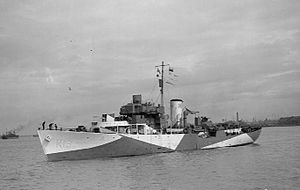HMS Vetch (K132)
 HMS Vetch in coastal waters off Liverpool
| |
| History | |
|---|---|
| Name | HMS Vetch |
| Ordered | 12 December 1939 |
| Builder | Smiths Dock Company, Middlesbrough |
| Laid down | 15 March 1941 |
| Launched | 27 May 1941 |
| Commissioned | 11 August 1941 |
| Decommissioned | 29 June 1945 |
| Out of service | Sold in August 1945 |
| Renamed |
|
| Reclassified | Merchant vessel in 1945 |
| Refit | Liverpool - 8 May-13 August 1942 |
| Identification | Pennant number: K132 |
| Fate | Scrapped |
| General characteristics | |
| Class and type | Flower-class corvette |
| Displacement | 1,060 tons |
| Length | 205 ft (62 m) |
| Beam | 33 ft (10 m) |
| Draught | 16.6 ft (5.1 m) |
| Propulsion |
|
| Speed | 16 knots (30 km/h) at 2,750 hp (2,050 kW) |
| Range | 3,500 nautical miles at 12 knots (6,500 km at 22 km/h) |
| Complement | 85 men |
| Armament |
|
HMS Vetch (K132) was a Flower-class corvette that served in the Royal Navy during the Second World War. After helping to escort many convoys and sinking two U-boats, she was decommissioned and sold in 1945.
Ordering and construction
As part of the 1939 War Programme, HMS Vetch was ordered on 12 December 1939 from
War service
In October 1941 Vetch was assigned to the
OG 74 was protected by the sloop Deptford and other corvettes (
Vetch arrived at Gibraltar on 27 September and 36 Escort Group remained there whilst escorting convoys HG 74 and OG 76 between 2 October and 11 November 1941. Whilst during offensive sweeps around Gibraltar, Vetch picked up and attacked a submarine contact on 6 December approximately 15 miles from Tarifa Point.
Convoy HG 76
76 HG was now led by Commander "Johnnie" Walker in HMS Stork. A large convoy, HG 76, consisting of 32 ships which sailed on 14 December 1941 from Gibraltar. Protection was from Audacity again and the sloops Stork and Deptford plus the corvettes Vetch, Convolvulus, Marigold, Pentstemon, Rhododendron and Samphire. Also detailed were Hunt-class destroyers HMS Blankney and HMS Exmoor as well as Town-class destroyer HMS Stanley.
Walker introduced new methods to combat the U-boat threat and successfully used Audacity's aircraft to locate submarines which were then attacked. During the convoy's journey five U-boats were sunk (U-127, U-131, U-434, U-574 and U-567) as well as two Condor aircraft, but the losses were heavy - Audacity (lost 21 December), Stanley (lost 19 December) and two merchant ships were sunk.
In April 1942 Vetch had been fitted with Type 271 radar with which, while escorting convoy OG 82 in the North Atlantic south-west of Ireland, she detected U-252 which she then sank with the help of Stork.[1]
36 EG was disbanded in June 1942 and Vetch continued with other escort groups until 1944. On 25 May 1943, while escorting a convoy to
On 29 June 1945, the Vetch arrived at Gibraltar and was put in navy reserve. On 23 August 1945 she was loaned to the Greek government and renamed Patrai.
Civilian service
The Greeks sold Patrai in 1951 and the vessel was renamed Olympic Hunter. In 1956 she was resold as the Otori Maru No.18 and sailed until 1966 when she was finally scrapped.
References
- HMS Vetch (K 132) of the Royal Navy – uboat.net
- British Escort Movements WW2 - Flower-class corvettes – naval-history.net
- ^ HMS Stork, sloop (entry for 14 April 1942 – naval-history.net
- ^ Bronson, David, Mosier's Raiders: The Story of LST-325, iUniverse, Bloomington, 2004, page 27
